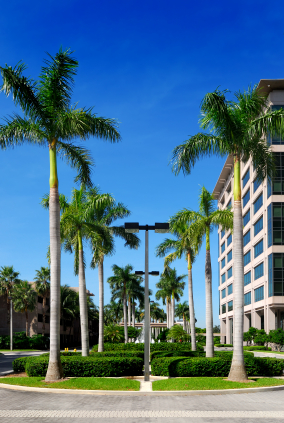Royal Palm Tree
The Royal palm is the quintessential palm tree that gives warm coastal cities like Malibu, Miami, and Tampa their luxuriously crisp white pillar effect. Think stretches of manicured perfectly lined up palms reaching a hundred feet tall on a trunk no more than a few feet in circumference. The architectural natural look of the royal palm makes it a great choice when creating a distinctive space. Royal Palms are a popular choice for high end shopping centers, cityscapes, and residences in California, Texas, Florida, Central and South America.

Mature Royal Palms
The Royal Palm, or Roystonea (formerly oreodoxa it was renamed after General Roy Stone, who served in the Caribbean) is one of the fastest growing palm trees. It can grow to 50-100 feet tall growing about a foot each year yielding visible growth sooner than most palms making it ideal for landscaping. Not to be confused with Cuban Royal Palms (Roystonia Regia) which differ from Florida Royal Palms (Roystona elata) in that the Cuban Royal Palms have more bulbous bottoms whereas the Florida Royal Palms have a more cylindrical light grey trunk. An example is Miami’s famous Biscayne Boulevard is lined with Florida Royal Palms creating a beautifully tropical barrier.
In the summertime Royal Palms boast fragrant 3-4 inch yellow flowers and inedible black fruits. Requiring full sun to partial shade and moderate water, Royal Palms can tolerate salt conditions and are a popular choice for coastal landscapes and urban environments when set aback from the water. Florida Royal Palms are native to cypress swamps, whereas the Cuban prefers dryer conditions. Florida Royal Palms will thrive in gardening zones 10 and 11 and prefer acidic soil. Through drought tolerant, Royal Palms prefer plenty of water and need good drainage. They have been known to survive short cold spells down to 28 degrees Fahrenheit, though this is not healthy for them.
Royal Palms are resistant to most insects and diseases however the Royal Palm bug is one to be wary of. It feeds on the young leaves of the tree causing them to look dry and black. Watch out for Royal Palm bugs in Early spring.





